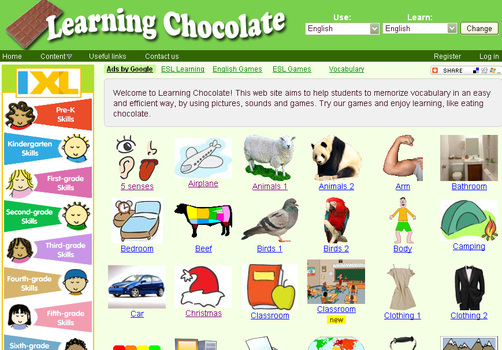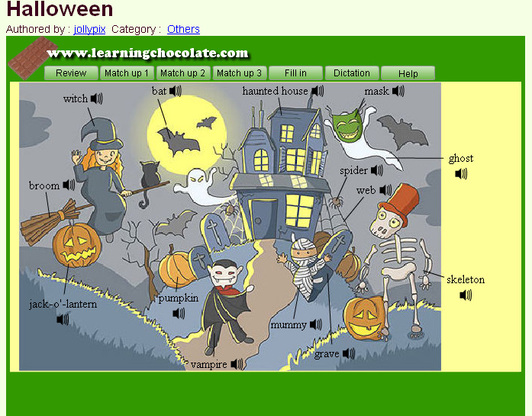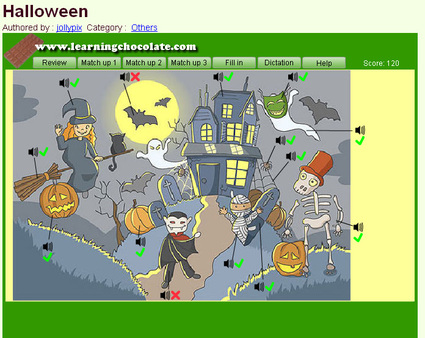Review of "learningchocolate.com"
About the tool
The website
“learningchocolate.com” is a tool that helps students to learn vocabulary of
various categories, e.g. animals, rooms in a house, food, holidays, vehicles
etc. The website is especially aimed at young learners and is probably able to
keep them busy for some time. At the moment the website provides about 100
categories, but some of them are closely related. You have the opportunity to
create your own user account in order to add further categories.
If you
click on a category you will find several vocabulary items and a picture of
each item. Furthermore you have the ability to listen to an audio file which
presents the correct pronunciation of each vocabulary item. The visualization
and the pronunciation of each vocabulary item help the students to memorize the
vocabulary better. In addition there are five different types of exercises
where you can test your knowledge. You are able to check your score and the
time you took to complete the exercise. After completing an exercise you get a
solution that shows you where you made mistakes. There are three “match up”-exercises
where you either have to attach an audio file to the corresponding vocabulary
item, or you have to attach a vocabulary item to the corresponding picture or you have to attach an audio file to the
correct picture. Then there is a “fill in”-exercise, where the pictures are
given and you have to fill in the vocabulary item yourself. The last exercise
is a dictation exercise, where you have to listen to the audio files and then write
down the words correctly. The website provides an explanation for every
exercise and the aim of “learningchocolate.com " is to make the students “enjoy
learning, like eating chocolate”.
You are
able to change the user language to Spanish, Mandarin or Japanese. Furthermore,
you can create a user account that allows you to create your own categories -
but I am not quite sure how and if it is checked concerning its accuracy. All
in all this tool offers activities that the students can do independently at
home.
The advantages
I think it
is a very useful approach to present the vocabulary items together with a
picture and their pronunciation. The visualization of the items makes it easier
to remember the vocabulary, but unfortunately there is usually no visualization
if students use the traditional way of learning vocabulary. In the traditional
approach the students have a list of vocabulary items and their translated equivalents.
And even if the phonetic transcription is given the students often are not able
to use it properly and therefore often do not pronounce words correctly. On
this website the students learn the pronunciation via an audio file which seems
to guarantee a greater success when it comes to pronouncing words correctly.
The categorization of the items also makes it easier to remember the words because students will automatically connect the words to each other if they are related. The vocabulary items cover many situations of everyday life and I consider this website to be appropriate for beginners to intermediate language learners.
Additionally, there is a variety of exercises that help the students to remember the vocabulary items. Some tasks practice the correct orthography while others help the students remember the correct pronunciation. The students can check where they made mistakes and this tool enables them to practice individually. In general, this approach is more interesting and more fun than the traditional approach of learning vocabulary and thus it is more motivating. The students can use this tool individually at home whenever they want to.
What I also like about his tool is that it is updated regularly. You can use your user account in order to create further categories of topics that may not be covered yet. You can contact other members for making suggestions or concerning corrections.
The categorization of the items also makes it easier to remember the words because students will automatically connect the words to each other if they are related. The vocabulary items cover many situations of everyday life and I consider this website to be appropriate for beginners to intermediate language learners.
Additionally, there is a variety of exercises that help the students to remember the vocabulary items. Some tasks practice the correct orthography while others help the students remember the correct pronunciation. The students can check where they made mistakes and this tool enables them to practice individually. In general, this approach is more interesting and more fun than the traditional approach of learning vocabulary and thus it is more motivating. The students can use this tool individually at home whenever they want to.
What I also like about his tool is that it is updated regularly. You can use your user account in order to create further categories of topics that may not be covered yet. You can contact other members for making suggestions or concerning corrections.
The disadvantages
If the website
aims at young learners or beginners of language learning it may cause difficulties
that there is no translated equivalent of the vocabulary items. In some cases
the students might not know what the word is referring to, even if there is an
arrow pointing at a certain part of a picture. Furthermore one could criticize
that not even a definition of the item is given if there is no translation of
the word. For advanced learners the vocabulary and the exercises may be too
easy and therefore this website could only be used for refreshing the knowledge
of these students. Unfortunately the categories usually do not contain abstract
vocabulary items because it is very difficult to visualize them. Thus mostly
concrete items are presented on this website. I do like the exercises because they
help the students to remember the vocabulary as well as the orthography and the
pronunciation. However, I criticize that the exercises do not differ too much from
each other and therefore they are rather simple to solve. I would have liked an
exercise where the students have to insert the new vocabulary into gaps within
a text or another exercise that has a different degree of difficulty.
Suggestions
I mentioned
before that no translated equivalent of a vocabulary item is given on this
website and this approach has advantages and disadvantages. For some learner
types it may cause difficulties and therefore I consider it to be a good idea
to create a button you can click on to get the translation of a word. Otherwise
the students would have to look up every word they do not know the meaning of and
this is rather laborious.
I also criticized that the exercises are very simple and not very differentiated. There are always the same five exercises in every category and there is no remarkable rise in the degree of difficulty. It would have been nice to use the newly acquired vocabulary in a certain context, e.g. a text where the students have to fill in gaps correctly. Or there could be exercises where a definition or the synonyms or antonyms of a word are given and the student has to find the correct vocabulary item. I also see a chance of including abstract vocabulary if one makes use of definitions or of synonyms and antonyms. This could make “learningchocolate.com” become more appealing for advanced learners. A nice task for advanced learners would be to get a user account and to create categories themselves. Or they could create their own website with vocabulary items that are relevant for a topic they currently deal with in class and they could also create exercises themselves. The students could try to include more complicated or abstract items and this website would be very helpful to learn new words for a vocabulary test. On this website a lot of information on the new vocabulary items would be collected, so that the students immediately had access to the correct orthography, the pronunciation, a definition, and for some words there would be a picture while for abstract items the website would provide synonyms and antonyms.
Under “Realization of my Suggestions” you find an example of how this website providing a variety of information on new vocabulary items could look like.
I also criticized that the exercises are very simple and not very differentiated. There are always the same five exercises in every category and there is no remarkable rise in the degree of difficulty. It would have been nice to use the newly acquired vocabulary in a certain context, e.g. a text where the students have to fill in gaps correctly. Or there could be exercises where a definition or the synonyms or antonyms of a word are given and the student has to find the correct vocabulary item. I also see a chance of including abstract vocabulary if one makes use of definitions or of synonyms and antonyms. This could make “learningchocolate.com” become more appealing for advanced learners. A nice task for advanced learners would be to get a user account and to create categories themselves. Or they could create their own website with vocabulary items that are relevant for a topic they currently deal with in class and they could also create exercises themselves. The students could try to include more complicated or abstract items and this website would be very helpful to learn new words for a vocabulary test. On this website a lot of information on the new vocabulary items would be collected, so that the students immediately had access to the correct orthography, the pronunciation, a definition, and for some words there would be a picture while for abstract items the website would provide synonyms and antonyms.
Under “Realization of my Suggestions” you find an example of how this website providing a variety of information on new vocabulary items could look like.




